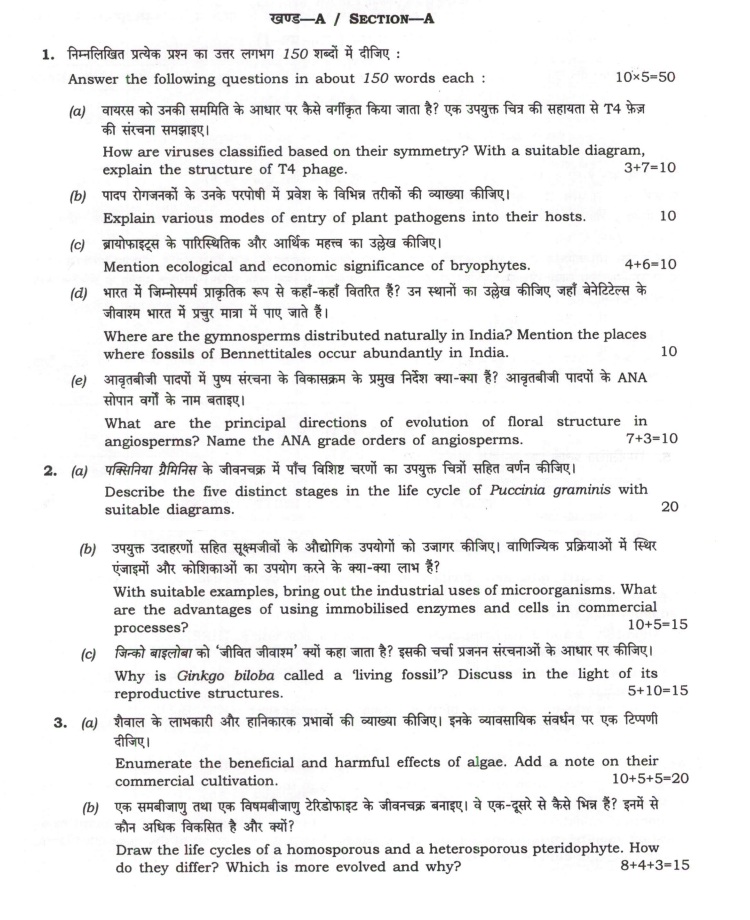(HOT) UPSC Current Affairs 2025 PDF
NEW! The Gist (NOV-2025) | E-BOOKS
(Download) UPSC MAIN EXAM : 2024 BOTANY (Paper-1)
(Download) CS (MAIN) EXAM:2024 Botany (Paper I)
-
Exam Name: CS (MAIN) EXAM:2024 Botany (Paper I)
-
Marks: 250
-
Time Allowed : Three Hours
खण्ड - A / SECTION — A
1. Answer the following questions in about 150 words each : 10×5=50
(a) How are viruses classified based on their symmetry? With a suitable diagram, explain the structure of T4 phage.
(b) Explain various modes of entry of plant pathogens into their hosts.
(c) Mention ecological and economic significance of bryophytes.
(d) Where are the gymnosperms distributed naturally in India? Mention the places where fossils of Bennettitales occur abundantly in India.
(e) What are the principal directions of evolution of floral structure in angiosperms? Name the ANA grade orders of angiosperms.
2. (a) Describe the five distinct stages in the life cycle of Puccinia graminis with suitable diagrams.
(b) With suitable examples, bring out the industrial uses of microorganisms. What are the advantages of using immobilised enzymes and cells in commercial processes?
(c) Why is Ginkgo biloba called a 'living fossil'? Discuss in the light of its reproductive structures.
3. (a) Enumerate the beneficial and harmful effects of algae. Add a note on their commercial cultivation.
(b) Draw the life cycles of a homosporous and a heterosporous pteridophyte. How do they differ? Which is more evolved and why?
(c) Compare the key features of classifications proposed by Hutchinson and Dahlgren. Discuss their merits and demerits.
4. (a) Describe the male and female gametophytes of Pinus. How are the processes of pollination and fertilization accomplished in Pinus?
(b) Illustrate the plant body of Psilotum. Add a note on the primitive characters of Psilotum which indicate its close relation to extinct group Psilotales. 10+5=15
(c) What are myxomycetes? Outline the life cycle of a typical myxomycete. Mention its protozoa-like and fungus-like characters.
खण्ड - B / SECTION —— B
5. Answer the following questions in about 150 words each :10 × 5 = 50
(a) What are the consequences of domestication of plants? Explain.
(b) Describe how successive cambia cause thickening of the stem in some flowering plants Name any two families that display this phenomenon.
(c) Distinguish various types of agamospermy. Why is apomixis now regarded a tool of practical importance?
(d) Write the botanical names, family and parts used of any five fibre-yielding plants.
(e) Differentiate between zygotic and somatic embryos.
6. (a) Describe different types of endosperm development in angiosperms. What is the significance of aleurone tissue? Mention the function of endosperm in seed.
(b) Explain and illustrate the characteristic features of Brassicaceae. Mention any five species of the family and their economic importance.
(c) Write an explanatory note on nutritional superiority of millets over cereals. Write the botanical names of any five millets grown in India. Mention the advantages of cultivating millets.
7. (a) Write an explanatory account of ethnobotany. Give a critical account of whether ethnobotany is a faith, myth or science.
(b) Compare the differentiation of xylem and phloem from the cells cut off by cambium. How is a vessel structurally different from a sieve element?
(c) What are the causes of variability in regenerated plants in tissue cultures? Give an account of utility of such variants in improvement of crop plants with examples.
8. (a) Basal media, growth regulators, sterilization and culture conditions are essential components of plant tissue culture techniques. Write an explanatory note on each of these components.
(b) How are pollen haploids produced? What are the methods to diploidize such haploids? Explain the importance of pollen haploids in agricultural research.
(c) "Polarity and symmetry are two essential components of morphogenesis in plants." Elaborate the statement.




